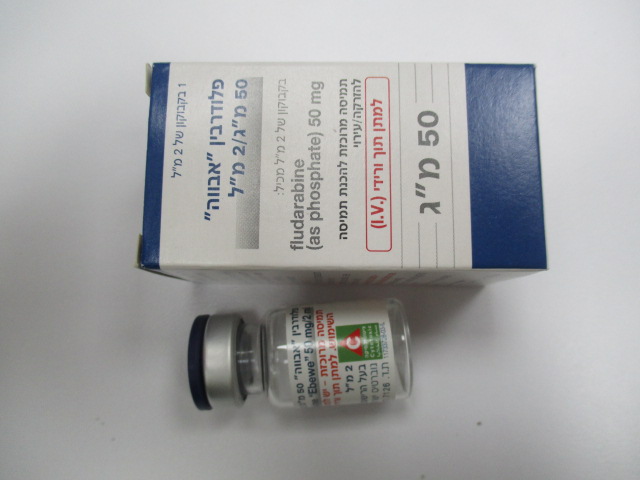Quest for the right Drug

פלודרבין "אבווה" 50 מ"ג/2 מ"ל FLUDARABIN "EBEWE" 50 MG/2 ML (FLUDARABINE PHOSPHATE)
תרופה במרשם
תרופה בסל
נרקוטיקה
ציטוטוקסיקה
צורת מתן:
תוך-ורידי : I.V
צורת מינון:
תרכיז להכנת תמיסה לאינפוזיההזרקה : CONCENTRATE FOR SOLUTION FOR INJECTION / INFUSION
עלון לרופא
מינוניםPosology התוויות
Indications תופעות לוואי
Adverse reactions התוויות נגד
Contraindications אינטראקציות
Interactions מינון יתר
Overdose הריון/הנקה
Pregnancy & Lactation אוכלוסיות מיוחדות
Special populations תכונות פרמקולוגיות
Pharmacological properties מידע רוקחי
Pharmaceutical particulars אזהרת שימוש
Special Warning עלון לרופא
Physicians Leaflet
Adverse reactions : תופעות לוואי
4.8 Undesirable effects Summary of safety profile Based on the experience with the use of fludarabine, the most common adverse events include myelosuppression (neutropenia, thrombocytopenia and anaemia), infection including pneumonia, cough, fever, fatigue, weakness, nausea, vomiting and diarrhoea. Other commonly reported events include chills, oedema, malaise, peripheral neuropathy, visual disturbance, anorexia, mucositis, stomatitis and skin rash. Serious opportunistic infections have occurred in patients treated with fludarabine. Fatalities as a consequence of serious adverse events have been reported. Tabulated list of adverse reactions The table below reports adverse events by MedDRA system organ classes (MedDRA SOCs). The frequencies are based on clinical trial data regardless of the causal relationship with fludarabine. The rare adverse reactions were mainly identified from the post-marketing experience. Very common (≥ 1/10) Common (≥ 1/100 to < 1/10) Uncommon (≥ 1/1,000 to < 1/100) Rare (≥ 1/10,000 to < 1/1,000) Not known (cannot be estimated from the available data) System Very Common Common Uncommon Rare Organ Class MedDRA and Infections Infections / Lymphoproliferat infestations Opportunistic i disorder ve infections (like (EBV- associated) latent viral reactivation, e.g. progressive multifocal leucoencephalo pathy, herpes zoster virus, Epstein-Barr- virus), pneumonia System Organ Very Common Common Uncommon Rare Class MedDRA Neoplasms Myelodysplastic benign, syndrome and malignant acute myeloid and unspecified leukaemia (mainly (incl cysts and associated with polyps) prior, concomitant or subsequent treatment with alkylating agents, topoisomerase inhibitors or irradiation) Blood and Neutropenia, Myelo-suppression lymphatic anaemia, system thrombo- disorders cytopenia Immune system Autoimmune disorder disorders (including autoimmune haemolytic anaemia, Evans syndrome, thrombocytopenic purpura, acquired haemophilia, pemphigus) Metabolism Anorexia Tumour lysis syndrome and nutrition (including renal failure, disorders metabolic acidosis, hyperkalaemia, hypocalcemia, hyperuricemia, haematuria, urate crystalluria, hyperphosphatemia) Nervous system Neuropathy Confusion Coma, seizures, disorders peripheral agitation Eye disorders Visual disturbance Blindness, optic neuritis, optic neuropathy Cardiac Heart failure, disorders arrhythmia Respiratory, Cough Pulmonary toxicity thoracic and (including pulmonary mediastinal fibrosis, pneumonitis, disorders dyspnoea) Gastro- Vomiting, Stomatitis Gastrointestinal intestinal diarrhoea, haemorrhage, disorders nausea pancreatic enzymes abnormal System Organ Very Common Common Uncommon Rare Class MedDRA Hepatobiliary Hepatic enzyme disorders abnormal Skin and Rash Skin cancer, subcutaneous necrolysis tissue disorders epidermal toxic (Lyell type), Stevens-Johnson Syndrome Renal and urinary disorder General Fever, Oedema, disorders fatigue, mucositis, and weakness chills, malaise administrati on site conditions The most appropriate MedDRA term to describe a certain adverse event is listed. Synonyms or related conditions are not listed, but should be taken into account as well. Adverse event term representation is based on MedDRA version 12.0. Within each frequency grouping, undesirable effects are presented in order of decreasing seriousness. Postmarketing experience with frequency unknown • Nervous system disorders o Cerebral haemorrhage o Leukoencephalopathy (see section 4.4) o Acute toxic leukoencephalopathy (see section 4.4) o Reversible posterior leukoencephalopathy syndrome (RPLS) (see section 4.4) Respiratory, thoracic and mediastinal disorders o Pulmonary haemorrhage • Renal and urinary disorder o Haemorrhagic cystitis Reporting of suspected adverse reactions Reporting suspected adverse reactions after authorization of the medicinal product is important. It allows continued monitoring of the benefit/risk balance of the medicinal product. Any suspected adverse events should be reported to the Ministry of Health according to the National Regulation by using an online form via the following link: https://sideeffects.health.gov.il/

פרטי מסגרת הכללה בסל
א. התרופה תינתן לטיפול במקרים הבאים: א. טיפול תומך בלוקמיה לימפוציטית כרונית (CLL) שאינה מגיבה לטיפול אחר. ב. טיפול התחלתי בלוקמיה לימפוציטית כרונית (CLL) ג. טיפול בלימפומה מסוג Non Hodgkin's שלב 3 עד 4 בחולים שלא הגיבו לטיפול בתכשיר ממשפחת ה-Alkylating agents או בחולים שמחלתם התקדמה במהלך טיפול או לאחריו. ב. מתן התרופה האמורה ייעשה לפי מרשם של מומחה באונקולוגיה רופא מומחה בהמטולוגיה או רופא מומחה בגינקולוגיה המטפל באונקולוגיה גינקולוגית.
מסגרת הכללה בסל
התוויות הכלולות במסגרת הסל
| התוויה | תאריך הכללה | תחום קליני | Class Effect | מצב מחלה |
|---|---|---|---|---|
| טיפול בלימפומה מסוג Non Hodgkin's שלב 3 עד 4 בחולים שלא הגיבו לטיפול בתכשיר ממשפחת ה-Alkylating agents או בחולים שמחלתם התקדמה במהלך טיפול או לאחריו. | 16/12/1997 | |||
| טיפול התחלתי בלוקמיה לימפוציטית כרונית (CLL) | 16/12/1997 | |||
| טיפול תומך בלוקמיה לימפוציטית כרונית (CLL) שאינה מגיבה לטיפול אחר. | 16/12/1997 |
שימוש לפי פנקס קופ''ח כללית 1994
לא צוין
תאריך הכללה מקורי בסל
16/12/1997
הגבלות
תרופה מוגבלת לרישום ע'י רופא מומחה או הגבלה אחרת
מידע נוסף
עלון מידע לרופא
11.10.21 - עלון לרופאעלון מידע לצרכן
11.10.21 - החמרה לעלוןלתרופה במאגר משרד הבריאות
פלודרבין "אבווה" 50 מ"ג/2 מ"ל